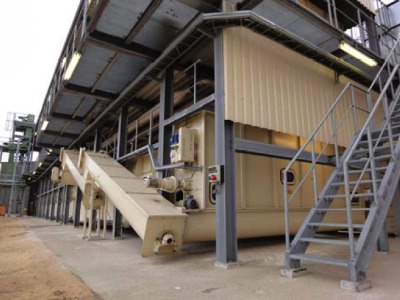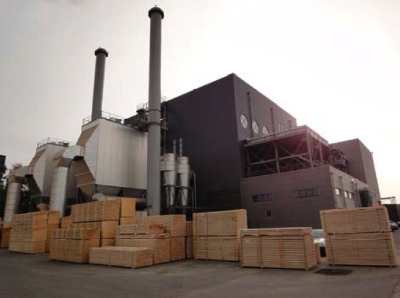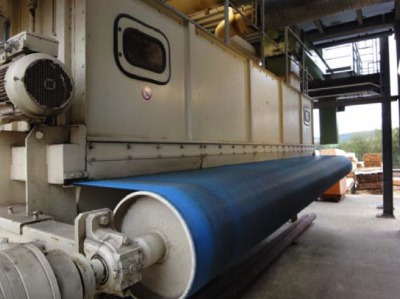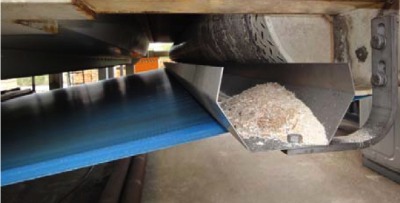
Turning down the heat
December 7, 2010
By GKD – Gebr. Kufferath AG
 |
 |
|
| Low-emission, low-temperature Kuvo belt dryers with process belts from GKD – Gebr. Kufferath AG.
|
Dec. 7, 2010 – Since wood pellets were
introduced in the German market about 10 years ago, their success has been
remarkable. Roughly 720,000 tonnes of pellets were produced during the first
half of 2010 in Germany alone. Industry calculations predict that by 2015,
500,000 pellet heating systems will be installed in private residencies, and
more than 1 million by 2020. Additional growth drivers are large power plants
with annual pellet consumption of up to 1.2 million tonnes. More and more
coal-fired power plants rely on wood pellets for power generation to reach the
legally specified limits for CO2 emissions. Unlike fossil fuels, the use of
wood pellets is largely CO2-neutral and thus climate friendly.
Industrie du Bois Vielsam & Cie. s.a.
(IBV), located in Belgium, is a European pellet manufacturer that also has its
own sawmill and power plant. For its annual pellet production of 150,000
tonnes, the company relies on low-emission, low-temperature belt dryers with
process belts from GKD – Gebr. Kufferath AG.
 |
|
| The biomass thermal power plant of the Industrie du Bois Vielsam & Cie. s.a. (IBV) in Belgium. Advertisement
|
Sawmill waste to energy
The IBV Group has three independent
wood-processing companies at three locations: two in Belgium and one in
Germany. The purchase of a small sawmill in 1999 marked the birth of the
Belgian IBV. After one year, with the help of a new sawing line, the cutting
capacity for logs had more than doubled from about 300,000 solid m3 of softwood
to 650,000 solid m3. In 2006, the sawmill expanded its product range to include
the manufacture of dried and planed lumber products. To cover the energy demand
required for efficient and environmentally friendly drying, IBV converted the
entire production process in Vielsalm, Belgium, to a CO2-neutral supply of
power and heat. This was made possible by building its own cogeneration plant
to burn sawmill byproducts. The power plant produces 20 MW of power, 30% of
which is used to cover the company’s power requirements. The remaining 70% of the
renewable energy is supplied to the public power grid. The power plant also
produces 45 MW of heat, which is used to dry all the lumber byproducts. The
waste heat is used for the lumber drying kiln and for pellet production.
Currently, plans to triple IBV Group's performance within the next three years
are moving ahead at full speed. The construction of a new site in France will
begin shortly. The start-up of a large sawmill for 500,000 m of softwood, a
biomass thermal power plant with 52 MW thermal capacity, and a pellet plant
with an annual production volume of 250,000 tonnes is scheduled there for 2013.
Christian Gebele, divisional director of energy at WTT, which is IBV's own
energy company, is again in charge of planning.
Low-temp dryers for wood chips
On the 32-hectare site in Vielsalm, the
power and pellet plant complex planned by Gebele in 2006 occupies about 6
hectares. Every day, 85 truckloads of logs and 60 truckloads of biomass arrive
at the facility, which operates non-stop 24 hours/day, 365 days/year. The
delivered logs are sorted according to customer specifications, recorded
three-dimensionally via computer, and measured. The logs are cut to order in
the sawmill. The sawdust and wood chips produced during this process are
shredded in a rotor chopper and hammermills to particles less than 10 mm in
size. The wood chips are transported to the drying plants via an extensive pipe
system. IBV uses two 205-m2, low-temperature, Kuvo belt dryers from Swiss
Combi/W. Kunz dryTec AG. Even though the stacked dryers can operate
independently, they work in parallel. The chips to be dried are spread onto the
endless permeable GKD Conducto 5065 mesh belt over the entire area via dosing
screws. In the process, levelling rolls ensure a uniform filling height of 80
mm. Heat exchangers installed above the belt are supplied with thermal energy
from the thermal power plant and heated to 80°C. Suction fans installed under
the belt use low pressure to draw the warm air through the product layer and
the belt. In doing so, the air is saturated with moisture, but also loaded with
dust.

|
|
| The GKD Conducto 5065 endless mesh belt is air permeable. |
The special mesh construction makes the
dryer belt highly permeable despite the small mesh openings, but also ensures
reliable dust retention, so no additional external air purification measures
are required to be in compliance with Belgian emissions limits. At the end of
the belt, the dust is removed together with the chip material. The dry top
layer is peeled off and removed. The remaining layer, which contains residual
moisture, is transferred via a discharge screw and conveyed to a second
distribution screw, which spreads the pre-dried layer again uniformly as the
top layer onto the layer cake. The warm drying air that passes through the cake
a second time extracts the residual moisture from the top layer, and the
resulting dry layer is peeled off again. A fan discharges the moist air to the
outside. The dryer adjusts the belt speed automatically depending on available
heat quantity and residual moisture level achieved. The moisture content of the
chips is 58% at dryer input and 8% at dryer output. The moisture content
measured at the output serves as a control parameter for the transport speed.
Any residue on the belt is removed by a rotating brush, and the belt is cleaned
by a high-pressure water blaster at regular intervals.

|
|
| A collecting tray under the belt contains chip particles.
|
Emissions far below limits
For IBV, the decisive factor for using
low-temperature dryers was their sophisticated technical concept and excellent
reputation. “When using the mesh belts, no additional dust treatment is required,”
says Gebele when explaining the advantages of the system. “We are almost 10
times below the limit value of the permissible dust exposure.” In Belgium, a
dust load of 20 mg/standard m3 is permitted (in Germany, 30 mg/standard m3).
The measured value of the belt dryer system at IBV is 2.7 mg/standard m3. The
mesh belts were supplied with the system. “The belts have been in non-stop
operation since 2008,” reports Gebele. Because the dryer is located outside,
the belts are subject to extreme weather conditions. Temperatures range from
–10°C outside to 80°C drying temperature. Despite the large weaving width (6 m
wide and 70 m long at IBV), the dryer belts are stable, stretch proof, and
abrasion resistant. Bronze wires woven throughout the mesh in the running
direction prevent electrostatic charging, following the ATEX directive. The
retention characteristics of the mesh construction prevent chip particles from
pushing through and reduce the cleaning requirements. Thanks to their
robustness and durability, four of these dryers and mesh belts are intended for
the new facility in France. Initial planning for the start-up of two additional
chip dryers has also commenced for Belgium. The objective is to run eight of
the low-temperature dryers over the medium term.
Pellet output
After buffering, the dried chips are ground
to less than 3 mm is size, axially injected into the pellet press at high
pressure, and radially pressed through the die. IBV pellets are certified for
the private consumer market according to the DIN Plus standard. However, the
majority of the 150,000 tonnes of annual production, an output of 20
tonnes/hour, is currently supplied to Belgian industry for power production.
As a climate-friendly and economic
alternative to fossil fuels, wood pellets are becoming increasingly important.
They are CO2-neutral, i.e., CO2 released during combustion is the same amount
as absorbed by the tree over its life. As regionally renewable, permanently
available fuel, they allow independence from heating oil and natural gas, which
are limited fossil resources. In October 2010, the price of wood pellets in
Germany was one-third less than that of gas and oil; this will continue to
accelerate pellets’ industrial use as an energy source. Throughout Europe, the
wood processing industry is preparing for this with increasingly larger and
efficient production facilities. Low-emission, low-temperature dryers can play
a role in efficient industrial production of high-quality wood pellets. Mesh
dryer belts like the Conducto 5065 combine high permeability at small mesh
opening with high thermal and mechanical stress. Gebele remains convinced about
this technology in the future as well. He says, "I am very satisfied with
the efficiency of dust removal, the robustness, and weather resistance of the
GKD dryer belts. We will use these belts also in our future plants."
Print this page